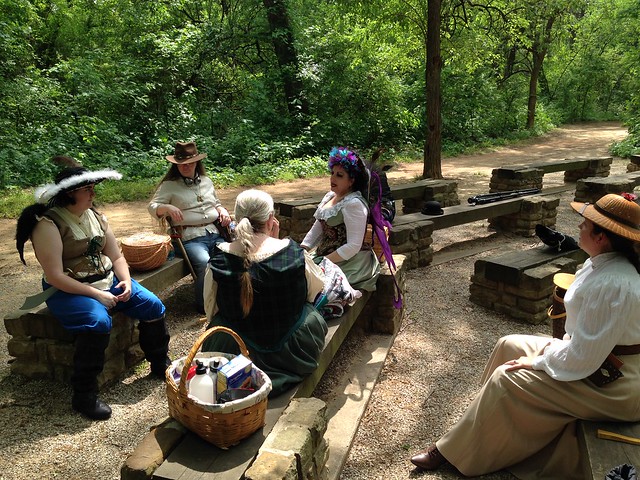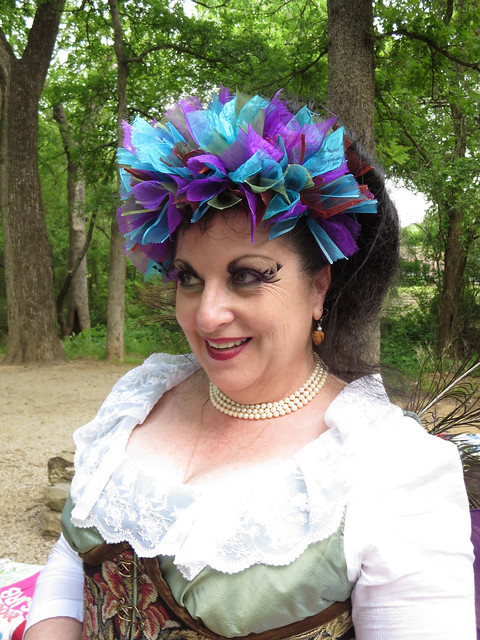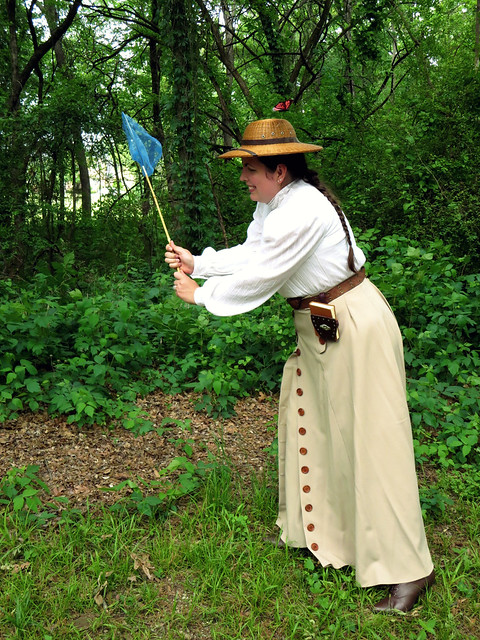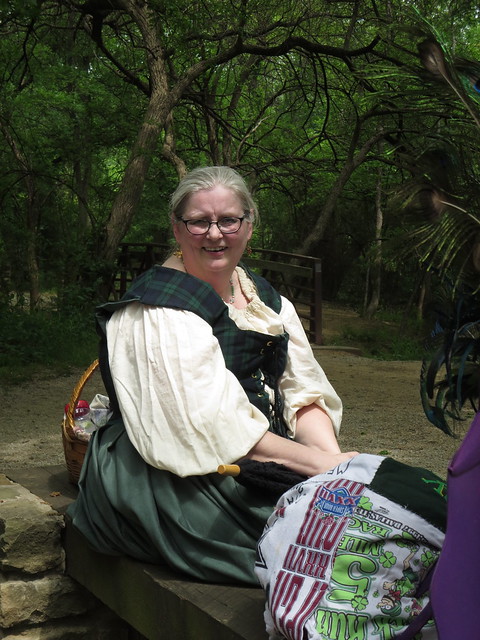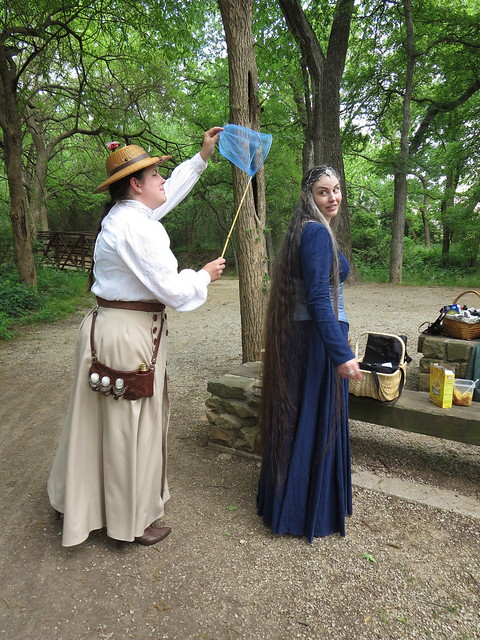This is a tutorial that describes how I created these two Legacy armor breastplates using 3mm Sintra (Closed Cell Foam PVC, a heat-formable pvc plastic), for ladies that have anatomy that requires the build materials to yield very compound curves.
... i.e. "big boobs"

The Yellow Armor (Maelie)
The Silver Armor (Jaelie)

Create/Customize Pattern
Tools Needed for this Section
1 ) Your undergarments, and armor vest
2 ) Pen or Permanent Marker
3 ) Masking Tape
4 ) Poster Board
5 ) Measuring Tape
Steps for Method 1
1 ) Put on all your supporting garments and vest.
2 ) Use masking tape to cover 1/2 of your torso area where you will want the breastplate to be.
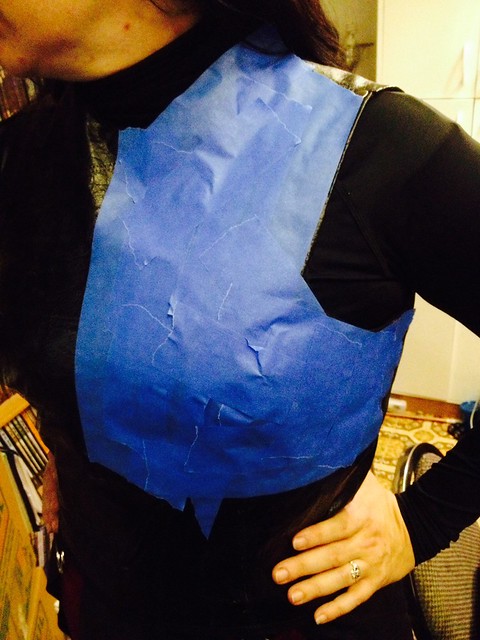
3 ) Use a marker to draw a centerline, and then trace the outer line of your desired armor.
4 ) Go in and mark where the darts will be with a single line.

5 ) Remove masking tape carefully
6 ) Cut "dart" lines and lay the pattern flat on posterboard or scrap paper

7 ) widen your darts by a few milimeters (if using 3mm sintra, add 1-2 mm to the dart width).
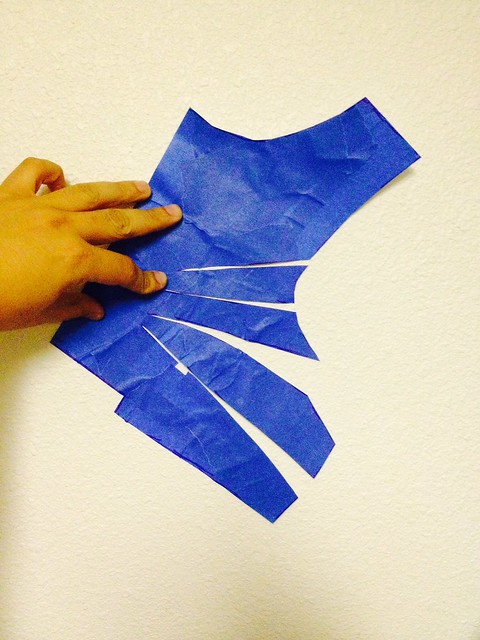
8 ) Redraw the pattern on posterboard (smoothing out your lines/cleaning up).
Steps for Method 2

1 ) Put on all your supporting garments and vest.
2 ) Measurement A is across the point of the bust and goes back towards the armpit however far as you want the armor plus about 1 inch for slop (I cut off about that much to even everything up later)
3 ) Measurement B is from the "A" line (point of bust) down to wherever you want the bottom to be. In Maelie's case it was basically back to the ribcage. Don't curve "up" (i.e. that place from whence boobsweat originates, the area under your breast/up against your ribcage - it's not a bra or bikini) with your measuring tape, if anything curve down to go with the flow of the armor plate (when you're done the goal is a graceful-ish line from your chest into your belly plates). No need to add anything to the measurement here.
4 ) Measurement C is across the top of the main breast mass, armpit to armpit. No need to add any extra inches here as you'll be sanding/cutting away anyway.
5 ) Measurement D is from top of shoulder (wherever you want the top of the armor to be) down to point of bust.
6 ) I then just kinda drew a freehand curvy line to connect those points. I only made half the pattern (i.e. the center is a straight vertical line), I then flipped it and traced it again to make the armor itself.
7 ) Then go in and draw triangular "darts" - I just eyeballed it - the point of the triangle should be just on the other side of the point of your bust (i.e. closer to your sternum than armpit)
8 ) The Purple E - is just where I discovered that, after forming the other "fingers" (as Maelie called them) I had to cut that one basically to a nub to get it to fit.
9 ) I made a pattern half, so I divided all the horizontal measurements (A & C) in half. If you don't want to do math, do the full thing.
Cut Out
Tools Needed for this Section
1 ) 3mm Sintra (or whatever you're using)
2 ) Pen or Permanent Marker
3 ) Something to cut whatever you're using
1 ) Take your pattern and trace it on to the Sintra (I found 3mm to be SO much easier to work with).
2 ) if you did a half pattern, Flip on the vertical line and draw the other half. I found that by doing it this way, I get it more symmetrical.
3 ) Cut out your Sintra however you prefer and sand the edges lightly. I used a band saw for everything except the center diamond, for that I used a hobby knife (just go over your lines several times, pushing lightly and it'll come out. The Sintra is soft)
Positive Forms
Tools Needed For This Section
1 ) Ehm... a credit card and access to Amazon?
2 ) Clear Plastic Fillable Ornaments
I used fillable Christmas Ornaments as my positive forms. Take a ruler to your most comfortable Underwire Bra and get a ballpark diameter of the wire itself, this is the diameter ball that you'll need.
For Maelie I used 120mm ornament (she wears a 34G US/34H UK), for Jaelie 100mm (34E US/34F UK). It can be small by an inch or more as the "mono-boob" (aka "sports bra") style will give you some flex with your measurements. Get close, but don't stress it if it's not exactly the same size as your underwire.
NOTE: Depending on how hot you like to get your Sintra, you may want to reinforce your positive mold. The colder you prefer to leave your Sintra, the stronger you'll need the form to be. I just poured Plaster of Paris into one of mine... now I have a weapon. If you are willing to run hotter Sintra (and wear a glove or whatever) you won't need this kind of reinforcement. If you use 6mm Sintra, reinforce your spheres.
Basic Forming of The "Fingers" (between the darts) using Heat Gun
Tools Needed For This Section
1 ) Heat Gun
2 ) Gloves
3 ) Your positive form
4 ) Your cut out armor
5 ) Your clothing on... ignore whatever your significant other says. You'll need to put the Sintra up to your body from time to time to check and it can still be uncomfortably warm.
Imagine each of these ornament halves flat side down on a table. This picture just gives you a general idea of how it'll look.
1 ) Heat up a single triangular "Finger" section (I went from the bottom, up to the armpit)
2 ) Form it over your positive form. Push down on all the corners and whatnot to try and get as smooth as shape as you can.
3 ) Repeat for all "Fingers" going around the spherical positive form.
~ ) When all your Darts are finished, form your shoulders and the rest of the breastplate as best you can. I preferred a straight plane down to the point of bust, but it's up to you really.
Fine Tuning Using Spacers
Tools Needed For This Section
1 ) Superglue
2 ) Little snips and scraps of Sintra
3 ) Masking tape
4 ) A friend you trust and/or like a lot...
You will notice that the individual "fingers" (Maelie's term) formed by the curved darts are springy and will not hold to your individual shape.
1 ) Get a friend you like well enough to let them play around near your chest (very up close and personal operation this... you can do it yourself, but it's harder).
2 ) Cut small rectangles of Sintra.
3 ) You'll need to insert those Sintra "spacers" in and around the edges of the "fingers" until the structure starts to stabilize. Use tape to hold them down.
4 ) When all the spacers are in, use a drop of superglue to "lock" each one in place.
The breastplate is starting to get rigid now/less springy.
Fiberglass and Resin
Tools Needed For This Section
1 ) Fiberglass Resin and Resin Hardening Drops (i.e. found in a Bondo Repair Kit or can be purchased separately)
2 ) Scissors
3 ) Cheap crappy paintbrush you're okay with destroying
4 ) Plastic cup you're going to throw away afterwards
1 ) Purchase a Bondo automotive repair kit.
2 ) Cut long strips of fiberglass the width of your gaps.
3 ) Put a single drop of superglue somewhere on the Sintra and "lock" the strip of Fiberglass in place. You just need it to not float around until you can pour the resin.
4 ) Mix up the Resin (I've found you don't need to be all that precise with ratios.... just remember, the more Drops of Hardener, the faster you need to work
5 ) Slather the resin onto your Fiberglass strips with the old paintbrush. You don't need to be precise, just slather it on there and get a good coating in place.
NOTE - Optionally you can follow the Bondo directions (mix resin, dip strip of fiberglass in resin, put strip in place) but I found it was very messy and wasted a tremendous amount of resin.
Now go away for an hour or two. Even better come back tomorrow. No really.
After the resin cures, it'll look a bit like this.
If you've got pokey bits on the inside (maybe the superglue hardened the fiberglass into a sharp pokey bit) just cut them off with a razor blade. If it's still pokey you can cover all this with Duct Tape when you're done. Maelie used Pink Duct Tape. It's pretty epic.
Bondo
Tools Needed For This Section
1 ) Something to mix the Bondo on (Silicone cookie sheet, foil, whatever) - a big flat surface is best.
2 ) 1 1/2" wide paint scraper (metal blade is best)
3 ) Something to scoop Bondo with (plastic spoon is fine... don't touch raw Bondo with anything else. It'll contaminate it and cause it to harden prematurely. Only scoop bondo with this spoon.)
4 ) Bondo "Body Filler" (not Putty or whatever else, basic red label Bondo Body Filler) and Red Cream Hardening Paste (both come in a Bondo Repair kit or can be purchased separately)
5 ) Good air circulation... or do this outside is best.
1 ) Scoop out the raw Bondo and drop it on your mixing surface (flat is best)
2 ) Squirt in some Red Cream Hardening agent (so the label tells you the ratio is this or that... piffle. Just remember "the pinker your Bondo the faster it hardens" ... that's it. A nice Salmon paste color hardens in just under 10 minutes so be quick.)
3 ) Mix it fast using your paint scraper. Smoosh it all around and get it mixed up. Pretend it's toxic cake icing.
4 ) Use the paint scraper to shove it into the holes.
5 ) Try to get it "smooth" ... but don't worry overmuch. You'll be sanding it anyway.
This is what it looks like from the resin side.
Now let it dry. No really, I know it's cool and you want to poke at it... leave it the heck alone for like 2 hours or more. Go watch one of the Star Wars movies or something. Best would be overnight. Bondo is hard on the outside after an hour or two, but chances are very good it's still uncured towards the center.
Sanding
Tools Needed For This Section
1 ) Palm Sander or whatever (you'll need both a "course" 80 or so grit and a "fine" 120-200 or so grit)
2 ) Patience
3 ) a sheet of 400 grit sandpaper
So you just sand it. You're going for no major ridges or high spots with the course sandpaper... then switch to the fine and do the rest.
You'll get it close and realize there are gaps and ridges and whatnot that you missed somehow (and you'll be certain you had gotten them all... right up until another gap pops up, like a weed). Like this:
So... Bondo again. Rinse and repeat.
Eventually you'll get fed up or be happy with the results (or both). If you have it you can switch to 400 grit sandpaper and finish up by hand... use sandpaper on your bare hand so its organic. Any gaps or pits at this point will become battle damage when you paint it so don't stress.
At this point, you have enough fiberglass and bondo on your armor that I call them "Fenders" ... Front Fenders to be exact, over near your headlights you see? Oh come on, you're making a breastplate... boob jokes are mandatory. Too serious and it all becomes a terrible chore... either that or I sniffed too much Bondo.
Trim
Tools Needed For This Step
1 ) Saw or Dremel
Now even up the edges to where you're happy with it.
That's more or less it really. Enjoy.
I attached the collar bit and the lames (horizontal belly bits) to the breastplate. You can use whatever pattern you like for those.
Maelie (black & yellow), Little Mando, Luke, Leia, and Jaelie (silver & black):

Jaelie's breastplate, after painting:

These same techniques could be used to construct fantasy armor, too.




